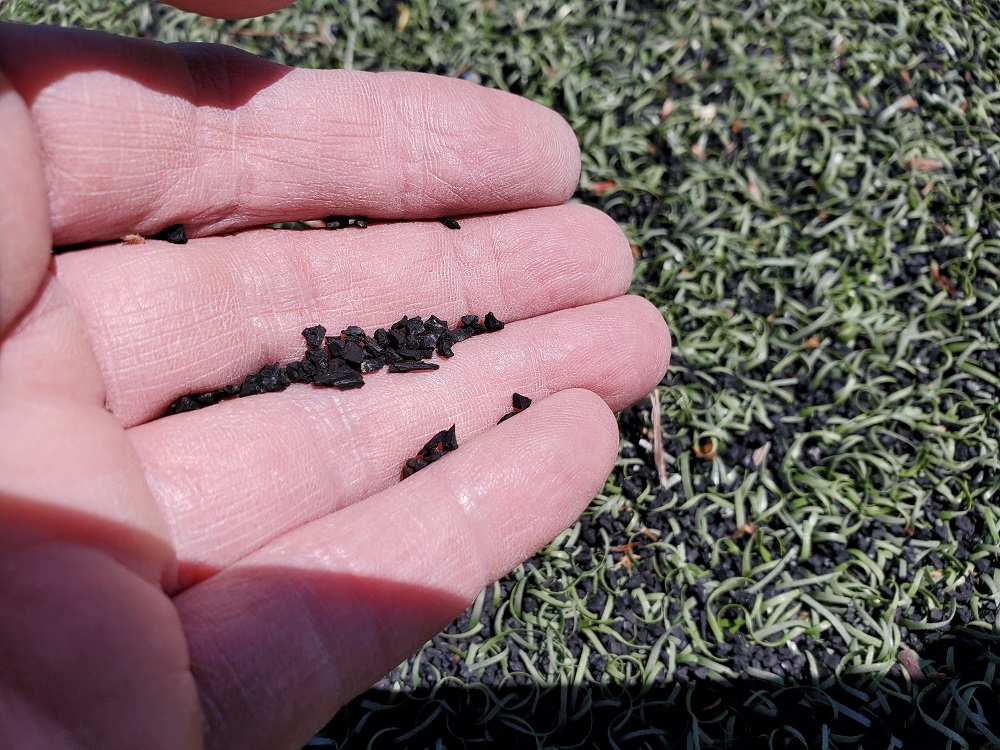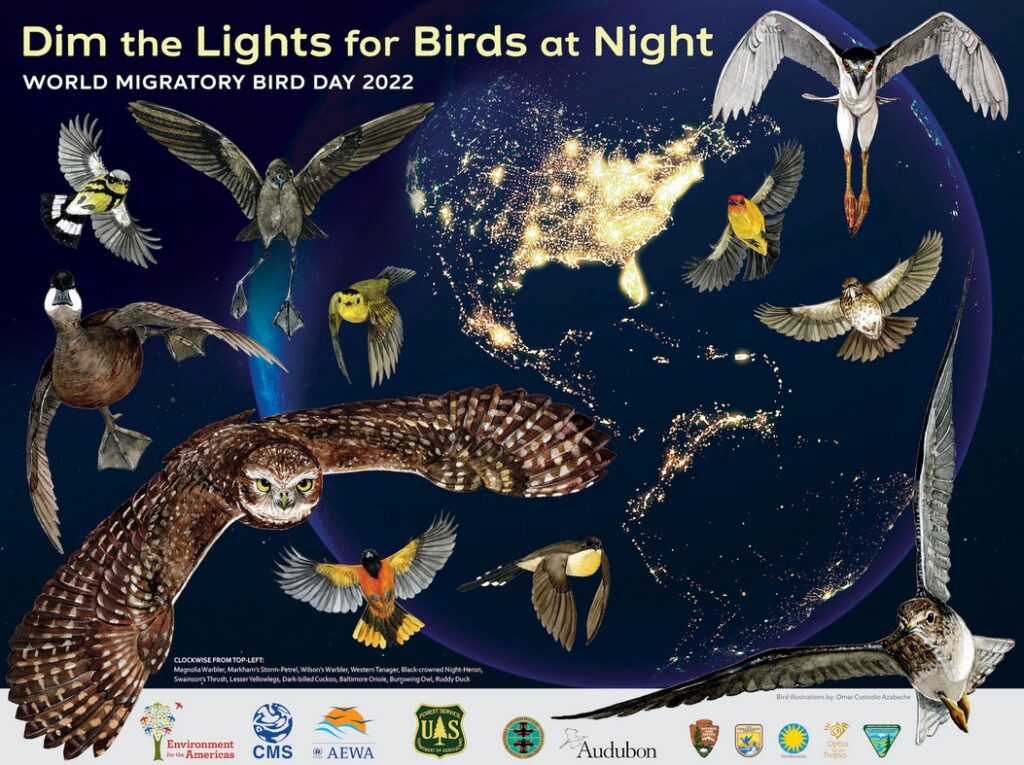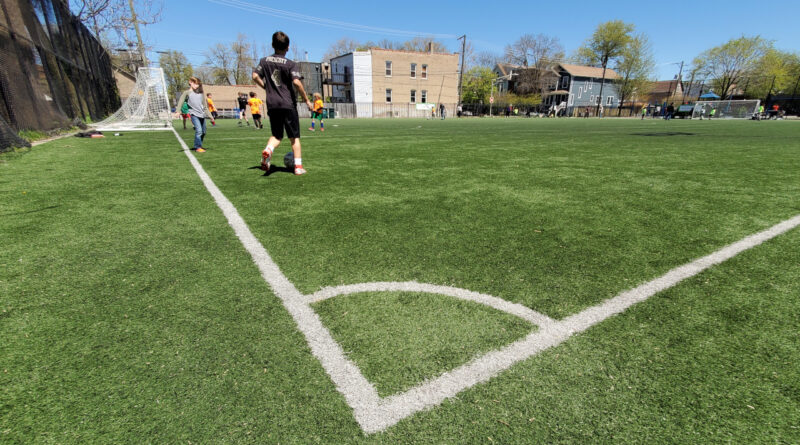The Hidden Dangers of Artificial Turf
Podcast: Play in new window | Download (Duration: 2:01:36 — 58.8MB)
Subscribe: Apple Podcasts | Spotify | Android | iHeartRadio | Podchaser | Email | TuneIn | RSS | More
(May 8, 2022) In case you hadn’t noticed, we’re not your usual “turf talk” kind of gardening show. Which means we don’t promote “weed n’ feed.” Or synthetic fertilizers. Or riding lawn mowers. Nope. Not that kind of show. But we do talk about lawns, even though that makes some folks scratch their heads. They sometimes say, “I thought you hated lawns.” My reply is that I know people like their lawns. So I want to make sure they grow them right. And then, after all of that good advice for my viewers, I get sucker-punched by the question of artificial turf. Go figure.
In March, the Lake Forest Parks and Recreation Board voted to install about 10.5 acres of synthetic turf at Deerpath Park. Their argument was that it would reduce weather-related cancellations of activities. What’s interesting about the Chicago Tribune article linked above is that there is no mention of the chemical properties of the turf.
Artificial turf ain’t sustainable
A group called Go Real Go Grass wants to fill in that gap. It calls itself “a group of athletes, parents, coaches, grandparents, citizens of Lake Forest, and concerned taxpayers.” They believe that natural turf is the proper choice and they’ve started a Change.org petition for their cause. One of the members is Yuh Schabacker-Koppel. She describes herself as a “community organizer and advocate” who founded Green Minds LFLB (Lake Forest/Lake Bluff) in 2014. She wrote to me,

I began reading up on it and was shocked over how under the radar this issue has gone. An average synthetic turf field contains about 40,000 lbs of plastic carpeting and 400,000 lbs of infill, often rubber crumb but more “natural” versions also exist. All of them though contain high levels of PAHs, mercury, lead etc. The fields shed about 3-5000 lbs of infill and plastic each year, which are replaced yearly. The plastic carpeting contains PFAS. A synthetic turf field has an average life expectancy of about 7-10 years before they must be entirely replaced. None of these materials can be recycled.
I think her reading must have included a story in the Atlantic with the headline The Dangerous Pileup of Artificial Turf. One of its main conclusions is that we really don’t know what to do with artificial turf once it has been used as artificial turf. And that’s a problem. Because most of that stuff ends up in landfills. Or worse, it never makes it to a landfill. At this point it is beyond question that artificial turf is not sustainable. That’s not stopping 1,200 to 1,500 new fields being installed each year, adding to 12,000 to 13,000 synthetic-turf fields that already exist the U.S.
Did we mention toxicity?
But back to the chemical problem. Schabacker-Koppel introduced me to a website called SynTurf.org, a remarkable repository of information. For instance, an article titled Hidden gotcha in artificial turf installations in Environmental Health News. That’s an unfortunately cutesy way of headlining an urgent issue.
Intrepid reporting by Sharon Lerner at The Intercept, in collaboration with scientists at the Ecology Center (Ann Arbor), revealed that the so-called ‘forever chemicals’—PFAS (perfluoroalkyl and polyfluoroalkyl substances)—are used in the production of artificial turf. They help in the manufacture of the artificial grass blades, which must be forced through an extruder to achieve the right size and shape. That process goes more smoothly when PFAS chemicals are added to the plastic before the blades are extruded.
‘Forever’ doesn’t mean they stay in the ‘grass’ blades forever. It means they take a very long time to degrade in the environment. And, rather than staying in the blades, they travel, by leaching and by volatilizing. With surface temperatures of artificial turf on hot, sunny days reaching well above 120 deg F, this traveling shouldn’t be a surprise. How much PFAS kids breath in while playing soccer hasn’t been quantified.
Physical and financial costs
Do you want your kid playing on that stuff? Not to mention that there is a “heat island” effect on artificial turf that can lead to extreme temperatures and heat stroke. And if you’re an athlete, artificial turf is harder on your body. It’s that simple.
By the way, those chemicals have a way of ending up in our waterways, whether the turf is landfilled or simply installed near a body of water. Unfortunately, Schabacker-Koppel tells me that the turf would be installed “in an area that frequently floods next to Skokie River.” However, one of the main pitches for using artificial turf is that it is cheaper than natural grass. But is that true?
“Maintaining a natural grass field is slightly more expensive than a turf field, but not by a significant margin. Plus, if one takes into consideration the $500,000 that must be paid every 8-10 years to replace the carpet of an artificial turf field, and the fact that it is at least $250,000 more expensive to implement, then using natural grass ends up being cheaper in the short and long run.“
The experts don’t even suggest you get artificial turf for your own backyard!
On today’s show, we talk to Yuh Schabacker-Koppel and her son Jocum, who is an student athlete in Lake Forest. They are joined by Lake Forest resident Mary Byrne Galea, who was educated as a biologist.
Midwest Grows Green webinars
We also welcome back Ryan Anderson from Midwest Grows Green (MGG). He doesn’t accept that you need to slather natural turf in pesticides to make it grow. He’s here to announce that Green Shield Certified (GSC), will introduce GSC for Landscapes. That program identifies and and promotes safer greenspaces for people, pets and pollinators. MGG will host two webinars to help companies, park districts, schools and municipalities achieve the standards.
First, representatives from The Conservation Foundation and Herbicide Free Campus will join MGG to detail their technical support programs during “Securing support for your sustainable landscaping project” webinar on May 10. (Register here.) Then Anderson shares pest and weed management practices and strategies that demonstrate proficiency in IPM, sustainable landscaping or organic landscaping. That happens at “Design, installation and maintenance characteristics of a GSC service or landscape” on May 12 (Register here.)
The boringest hobby
Saturday, May 14, is a big day. I mean that literally. It is Global Big Day, organized by the Cornell Lab of Ornithology. To participate, just sign up for a free e-bird account. Not surprisingly, Big Day coincides with World Migratory Bird Day (WMBD). Coincidence or conspiracy? We may never know.

The overall mission of World Migratory Bird Day is to raise awareness of migratory birds and issues related to their conservation. This year, the day focuses on the impact of light pollution on migratory birds. Dim the lights for birds at night!
So it’s only fitting that we talk to one of our favorite birders. Bob Dolgan created Turnstone Strategies LLC and This Week In Birding. But he is better known for the Monty and Rose films. In fact, Monty & Rose 2: The World of Monty & Rose will air today (May 8) on WTTW in Chicago. Dolgan joins us today to answer the question on every Chicagoan’s mind: where is Rose? Monty has returned to Montrose Beach on the City’s north side. But Rose is AWOL…so far. There was even a new piping plover spotted at Rainbow Beach on the south side. Still, Rose remains missing.
Dolgan will show us some of the birds he has observed lately. And we’ll give him a chance to comment on a study by the University of Essex that lists birding among the most boring hobbies. He takes umbrage with that report in a recent post in This Week in Birding. We’ll let him rant on today’s show. Speaking of rants, I could do one on Chicago’s efforts to establish a casino in the City. Bird will not benefit. Don’t get me started.
Some birding events this week
Cook County Forest Preserves Events on May 14
Good bird watching sites:
Forest Preserve District of Cook County
Chicago Ornithological Society
Chicago Audubon Society
World Migratory Bird Day at Hackmatack National Wildlife Refuge
HOORAY for Birds! Day in Hammond, IN
The Green Dispatch
No Rick DiMaio for the next few weeks, so we’ll entertain (or depress) you with stories about the state of the planet. First, we look at a heat wave on the Indian subcontinent.
A climate scientist on India and Pakistan’s horror heatwave, and the surprising consequences of better air quality – The Conversation
Populations declining for 48% of world’s bird species – Birdwatching
Disasters – those we see and those we don’t – Unspun
Once under imminent threat, a strip of rare Illinois prairie gets a temporary reprieve – WBEZ Chicago
Some Chicago birds are nesting nearly a month earlier than they did more than a century ago, Field study shows – Chicago Tribune
From King Cobras to Geckos, 20 Percent of Reptiles Risk Extinction – The New York Times
Trash or Recycling? Why Plastic Keeps Us Guessing. – The New York Times
Chicagoans Respond to Chicagwa, Mayor Lightfoot’s Canned Water Gimmick – Eater Chicago
Total Lunar Eclipse Could Be Visible From Chicago This Month – NBC5 Chicago
If You Think Kale Is ‘So 2010,’ You’re Not Growing the Right Ones – The New York Times

